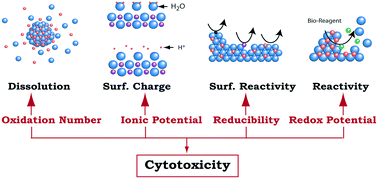Assessment of cytotoxicity of metal oxide nanoparticles on the basis of fundamental physical–chemical parameters: a robust approach to grouping
Abstract
Due to their sizes, nanoparticles can penetrate into biological systems easily; anticipating their harmful interactions at the cellular level makes it possible to safeguard workers, consumers, and the environment effectively. Decades of research have identified key properties of nanomaterials that induce adverse responses, and this evidence suggests that the toxicity of a nanoparticle can be inferred from its abiotic behavior. Experimental physical–chemical characterization of nanoparticles, however, is complex and time consuming, and the absence of any standardized method has generated controversial results. This paper shows how known adverse modes of action of nanoparticles arise from fundamental physical–chemical parameters that don't need any experimental quantification. We show that cytotoxicity of metal oxides in different types of in vitro systems, which include E. coli, rat alveolar macrophages, human bronchial epithelial cells, Daphnia magna, and Aliivibrio fischeri, can be foreseen on the basis of the values of oxidation number (Z) and ionic potential (IP) of the cation, and surface reducibility (SR), and redox reactivity (RR) of the oxide. Importantly, the values of these fundamental physical–chemical parameters can be easily deduced from the chemical formula of the nanoparticle with the help of a periodic table. Combining these parameters in a naïve Bayes classifier, a robust probabilistic model that can be run on a pocket calculator, makes it possible to determine the most probable level of toxicity of a nanoparticle given its composition. Results indicate that the probability that nano-oxides exhibit very high cytotoxicity (EC50 < 10−3 mol L−1) decreases with increasing oxidation number Z of the cation; high values of Z, however, may become unstable and activate adverse redox processes; in contrast, stable, redox-inert reducible oxides tend to be, probabilistically, less toxic than oxidizable ones.



 Please wait while we load your content...
Please wait while we load your content...